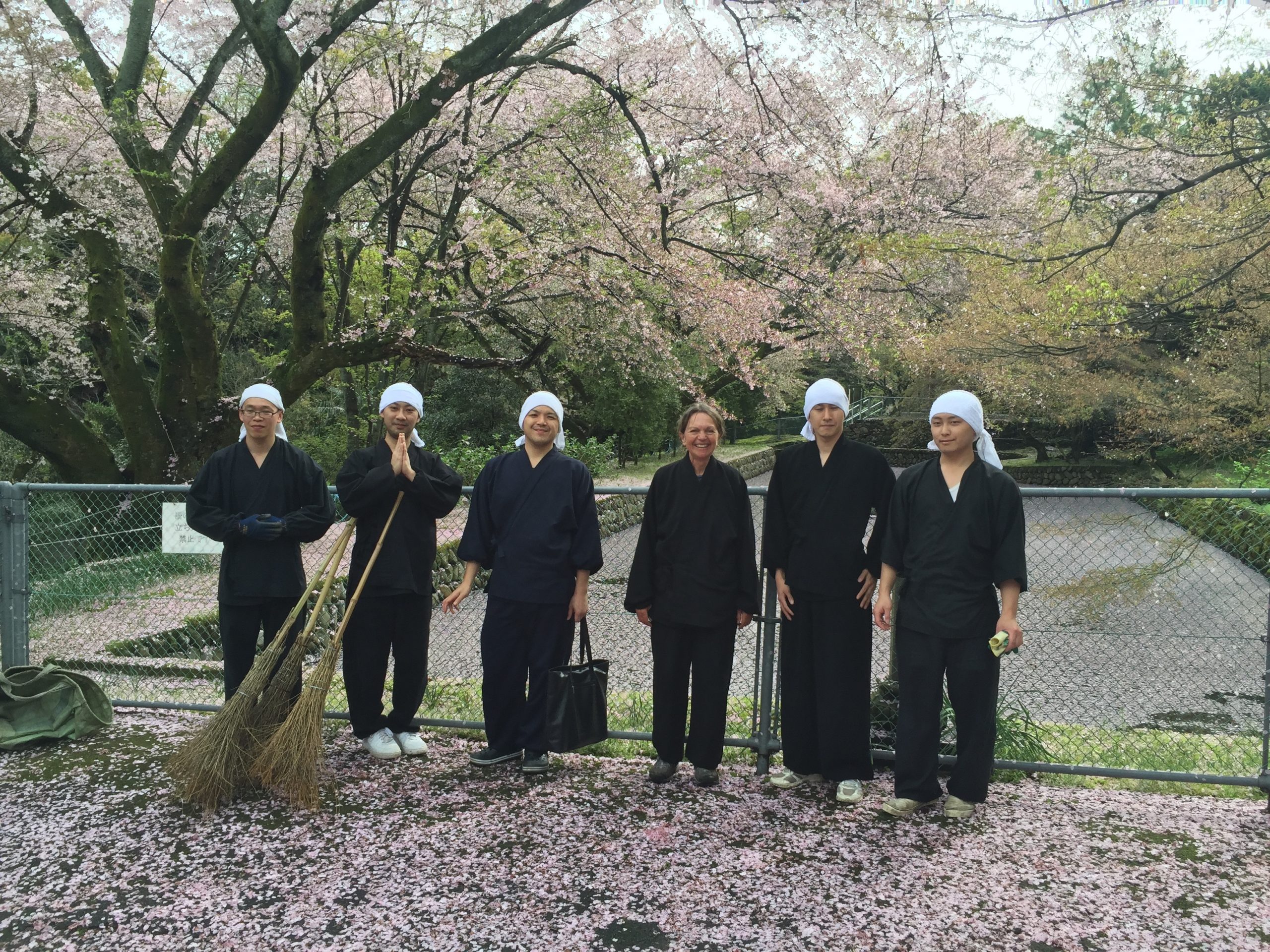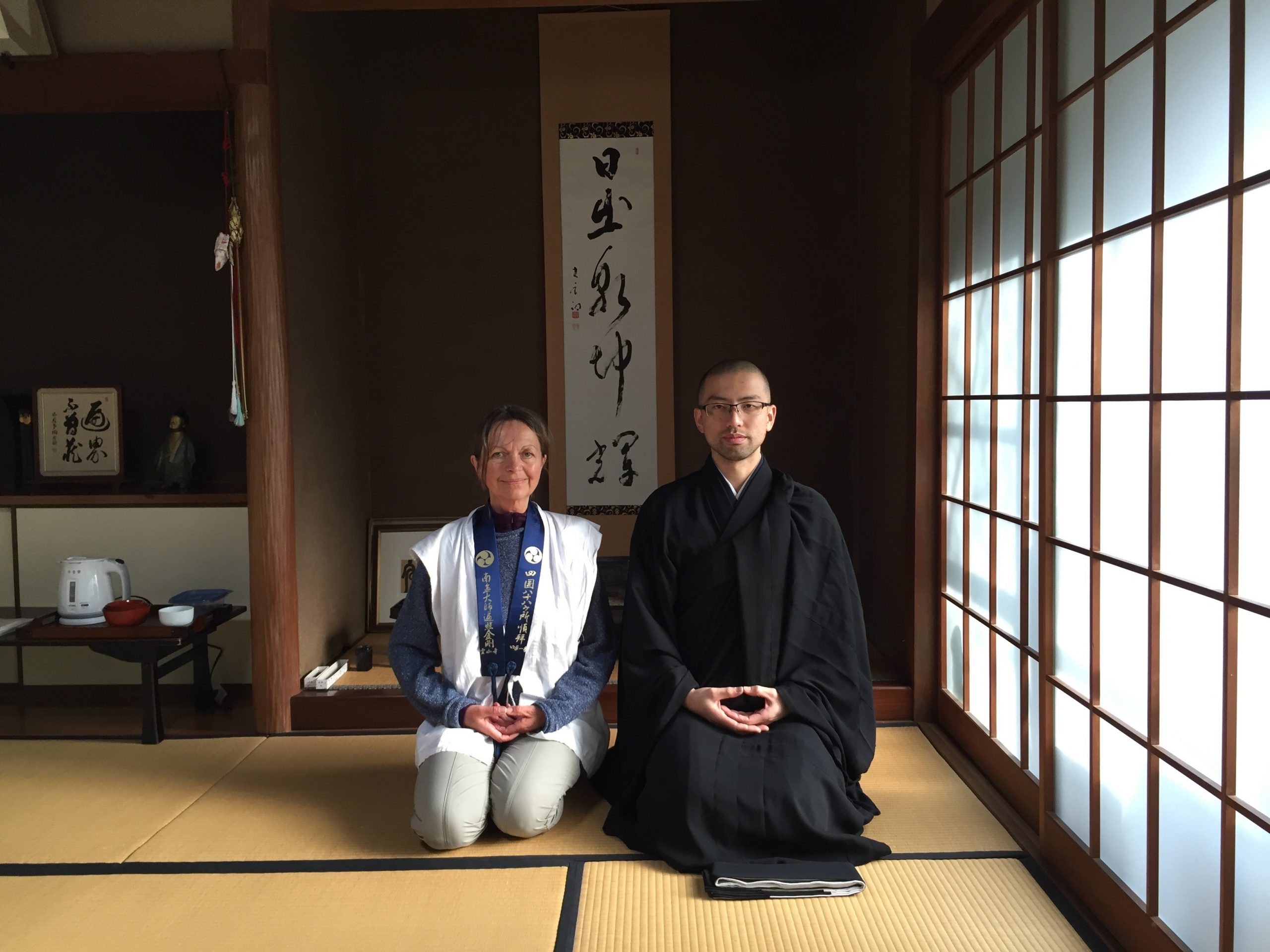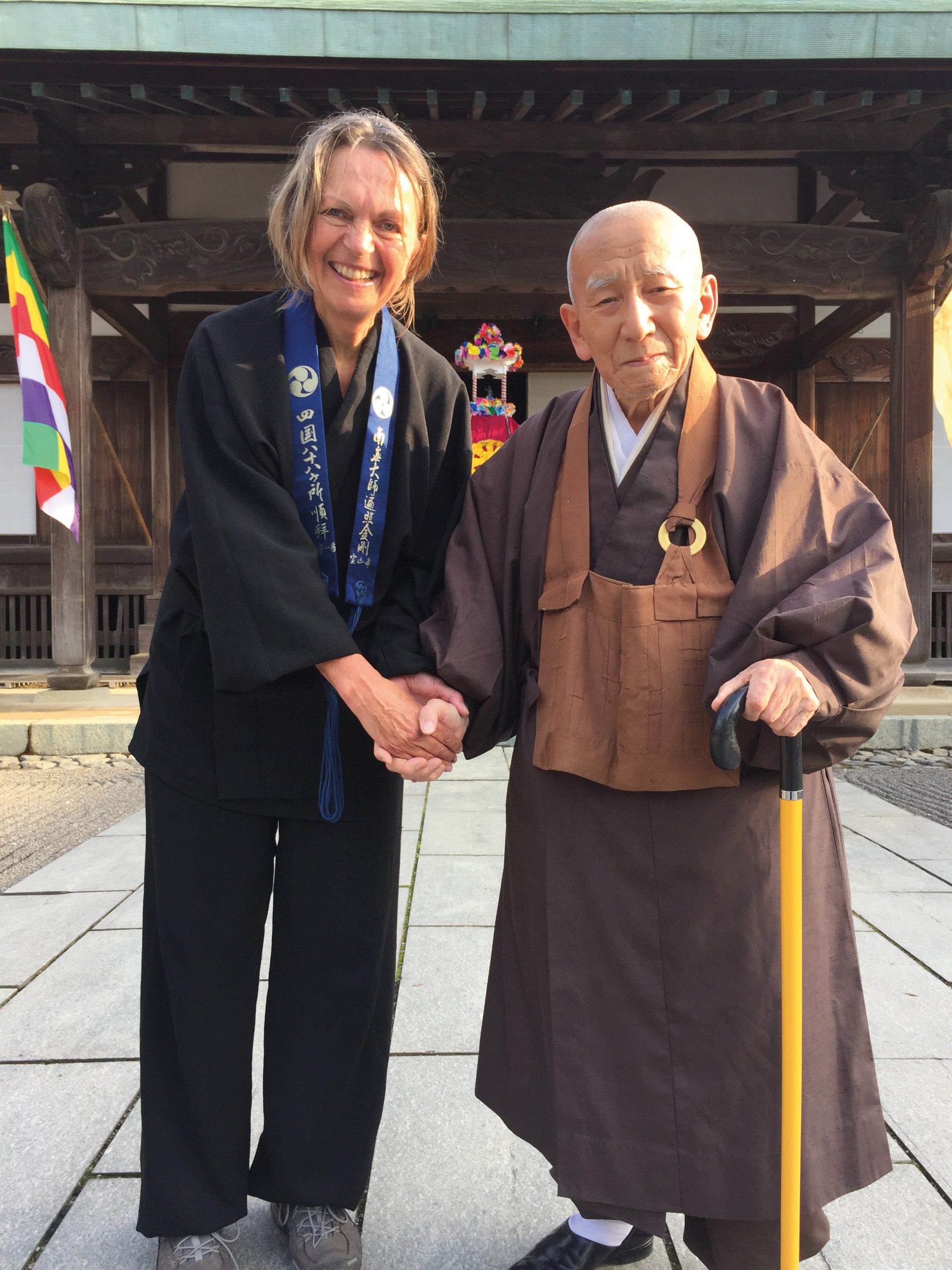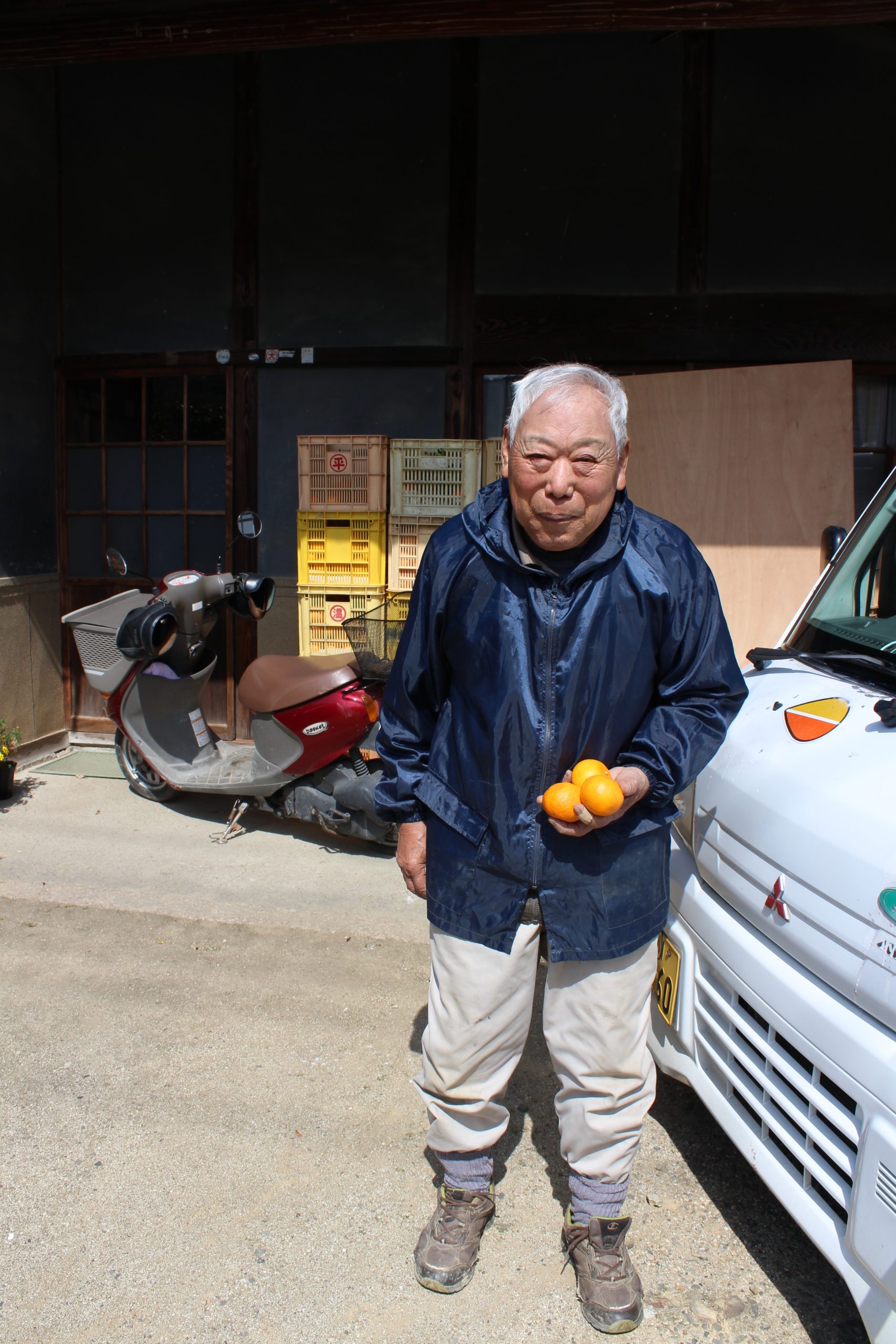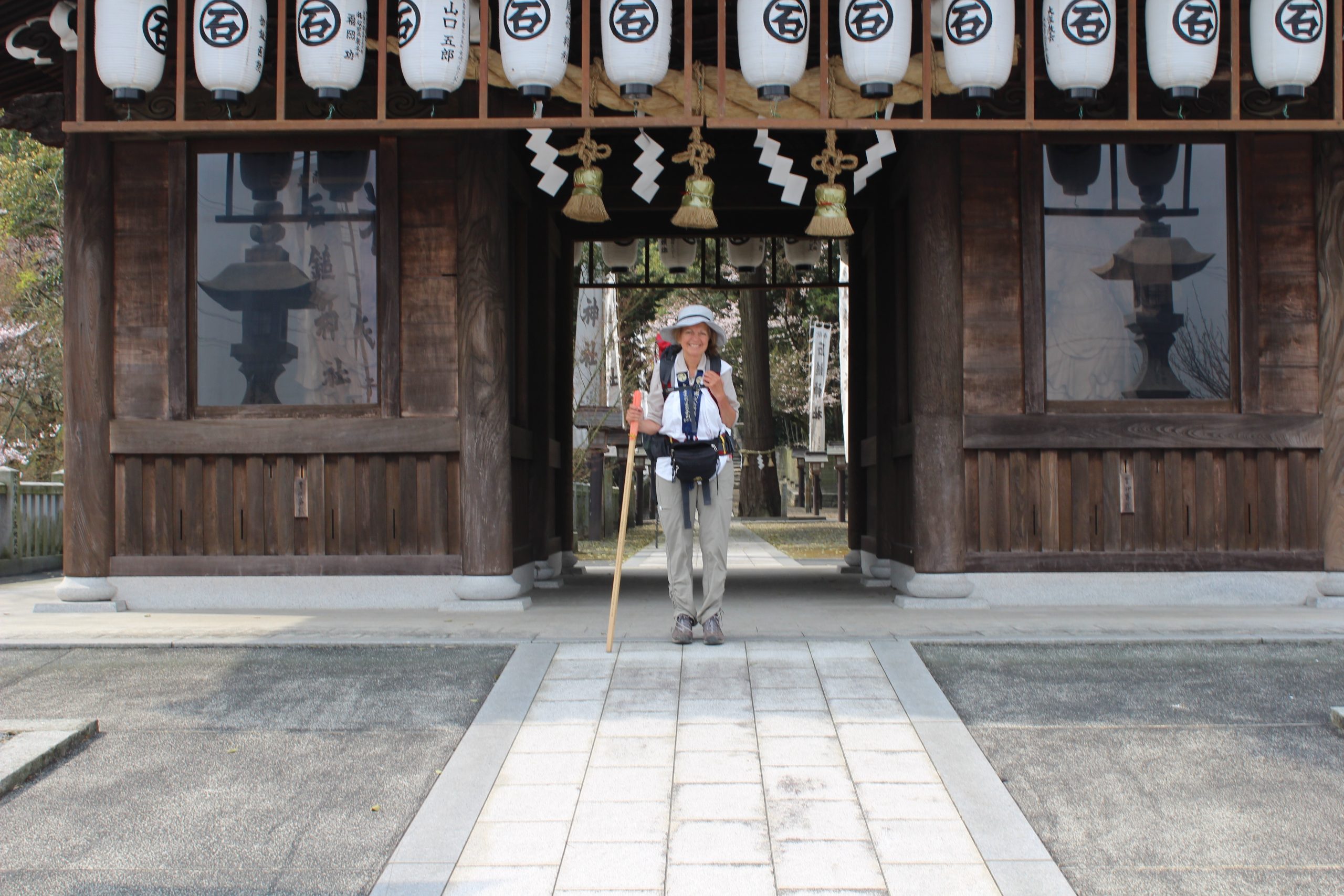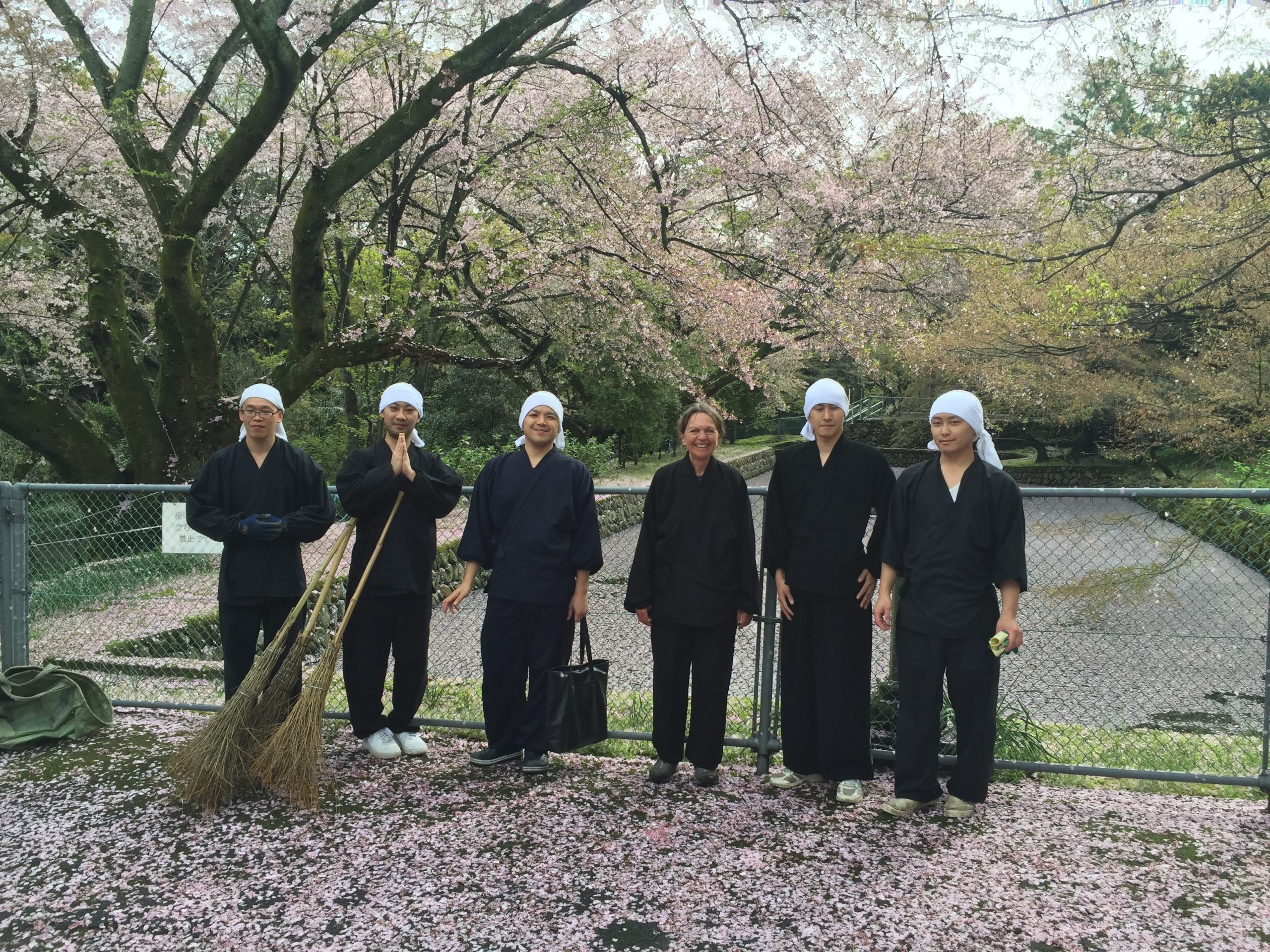They say that Kōbō Daishi is accompanying the pilgrim on this pilgrimage at all times. This is expressed through the sentence: “dōgyō ninin”. I could replace Kōbō Daishi with “Inner Trust in that what just is”. By trusting life, each moment was filled with vitality and joy despite difficulties and times of feeling lost, helpless, fearful or tired.
Aside from the 88 temples, I also visited many Shintō shrines and bangais, which are temples that do not belong to the group of 88 temples. I also stayed at the Zen temple Zuiōji in the prefect of Ehime. I have been a practitioner of Soto Zen for a long time. The recommendation to spend a few days there came from my Zen teacher, Rosan Yoshida Rōshi. Zuiōji was his training monastery. It is one of the most traditional Sōtō Zen training monasteries in Japan. As it happened, it was situated on my route and I obtained permission to practice there with the monks.
.
.
.
.
.
With monks
.
.
.
Heavy rain was falling when I entered the monastery district. The dense fog above the top of the trees mirrored my inner feelings. I had great doubts, if the decision to come here had been the right one. The straight lines of the big stone garden in front of the building with the green copper roof seemed to be threatening and unfriendly. I did not know where to go and followed a path that led me directly into the kitchen. There, the cook (tenzo) received me with a big smile and said: ” You must be Garyō-san. Welcome to Zuiōji!” These words chased away all my doubts. It was like coming home.
.
.
.
.
.
With Daikai-san
.
.
.
I stayed in Zuioji for 8 days, including Buddha’s birthday on April 8. Daikai-san (tenzo) was the only person who spoke English and also knew German. After showing me my room, he introduced me to the schedule and rules. He explained how to enter the sodo, how to walk, how to get on the tan (platform) for zazen, how to eat the traditional way of oryoki, where to change slippers, go barefoot or wear white socks, when to sit in seiza. He gave me the schedule of the day starting at 3:50 am in the morning and ending at 8:55 pm with zazen. Soon, I was overwhelmed and expressed my feelings to him. He answered “do not worry! I will be here to help!” And this was right! It was not only him who helped me but I felt the support of the whole community of monks. In addition, buildings, timing and rules support the practice of the Buddha mind and create a flow which feels like a strong current carrying one forward. I just had to follow this flow and do my best. It was very interesting that the greeting of the monks “otsukaresamadesu” (thank you for your effort) expressed the energy I felt in Zuioji. Despite my many mistakes, I felt included and part of the whole.
I especially appreciated meeting the over 90-year-old abbot Tsugen Narasaki Roshi, who was for me the living Dharma. When I left Zuioji to continue my pilgrimage, he suggested a goodbye photo in front of the white elephant placed before the hatto at Buddha’s birthday. I value this photo very much!
.
.
.
.
.
With Tsugen Roshi
.
.
.
The Shikoku pilgrimage was a wonderful experience where I could witness the tremendous kindness of Japanese people, the beauty of the country and the richness of the culture. However, by walking I also saw huge problems in the countryside. Especially in the prefecture of Kochi, the countryside looked abandoned and full of poverty. I saw trash piled up beside the street, crammed into abandoned houses or broken-down cars. Still full furnished houses collapsed with nature taking over the site because nobody cared after the last resident died. Walking on many asphalt roads and especially through tunnels without a pedestrian walkway made the pilgrimage exhausting and sometimes dangerous. In addition, bus tourists often occupy the shukubos and a singular pilgrim does not have much chance to stay in the temple, which is a pity!
.
.
.
.
.
Osettai with mandarins
.
.
.
As pilgrimages by foot become more and more popular in Europe as well in the US, the old Japanese pilgrimage routes of Shikoku und Kumano Kodo have tremendous potential to attract people coming to Japan. The focus, however, needs to shift more towards people who walk than towards bus pilgrims.
I am very grateful that I could walk the pilgrimage and experience Japanese life and culture in such an authentic way! More information about the pilgrimage and my experiences can be found in my book. A shorter version of the path is on my blog:
Simplyjustwalking.com
.
.
.
.
.
In front of the Mountain Gate of Ishizuchi Shrine
.
.
.
.
私の四国八十八カ所巡り 後編
ゲルトラウト・ヴィルト
当協会理事・岩谷滋雄さんの知り合いのオーストリア人、ゲルトラウト・ヴィルトさんが徒歩で四国八十八か所巡りをしました。そこでその様子を 2回に渡ってお送りします。原文は英語で、岩谷滋雄さんと祐子さんに翻訳してもらいました。
<弘法大師はじめ先達たちの教え>
お遍路では弘法大師がいつも巡礼者と共にいると言われ、「同行二人」と表現されます。ここで言う「弘法大師」は、私にとっては「生けるものに対する信頼感」と同義ではないかと思っています。この信頼感を持つことにより、色々な困難に直面し、方向を見失い、無力感を感じ、恐怖や疲労感が襲ってきたとしても、心は常に活力と喜びに満たされるのです。
<禅寺修行>
88ヶ所の札所以外にも多くの神社や「番外」と呼ばれるお寺も訪ねました。また愛媛県では瑞應寺という禅寺に短期間滞在しました。長年曹洞宗の禅修行をしてきましたが、私のミズーリの禅の先生の吉田老師からその寺での短期修行を勧められていました。瑞應寺は老師自身が修行したところで、伝統ある曹洞禅修行道場の一つです。たまたまお遍路のルート上にあり、僧侶たちと共に修行をする許可を得ることが出来ました。
.
.
.
.
.
瑞應寺の僧侶たちと
.
.
.
瑞應寺にたどり着いた時は大雨でした。濃い霧が木々を覆い、まるで私の心の内を映し出しているようでした。ここに来るという決断が正しいものだったのか、疑念を持ち始めていました。緑色の銅板屋根の建物の前の箒の目も鮮やかに掃き清められた大きな前庭の中をまっすぐに伸びる石の小径は、人を寄せ付けない雰囲気を持っていました。どこに行けばよいのか分からず、その小径に沿って歩いて行くと庫裏 ( 台所)に行き当たりました。そこで典座 ( 禅寺で食事などの事をつかさどる役僧 ) の大海さんが私を見るなり「雅了さん(トラウデが吉田老師にもらった名)ですね?よくいらっしゃいました。」とにこにこ顔で迎えてくれました。私の不安は一辺に消え去り、ま る で自分の家に戻ったような気持ちになりました。
.
.
.
.
.
大海さんと
.
.
.
<僧侶の導きで日々のお勤め>
お釈迦様の誕生日である 4 月 8 日までの 8
日間を瑞應寺で過ごしました。大海さんは唯一英語を話せる僧侶で、ドイツ語も出来ました。彼は、まず私が住む部屋に案内してくれたあと、日々の日課や規則を説明してくれました。僧堂 ( 修行の根本道場 )への入り方、歩き方、座禅をする単(禅堂において各自が座る座席 ) への上がり方、伝統的な応量器 ( 禅僧が使う食器 ) の使い方、どこでスリッパを履き替えるか、裸足になるか、白足袋になるか、いつ正座するか、等です。朝 3 時 50 分の起床から夜 8 時 55分の座禅まで、一日の日課についても説明してくれました。これらを一遍に聞かされた私は不安に駆られ、守れる自信がとてもないと彼に伝えました。大海さんは「心配しないでください。僕が助けますから。」と言ってくれ、まさしくその通りになりました。彼だけでなく、僧侶たち全員が助けてくれました。更に、伽藍と決められた日課や規則は、修行をする助けになることが分かりました。それらは、人の背中を押してくれる強い風圧のようなもので、その力に身を任せてベストを尽くすだけで良いのだと分かりました。僧侶たちのかわす「お疲れ様です。」という挨拶は、瑞應寺に満ちるエネルギーを象徴しているように感じられ大変面白いと思いました。沢山の間違いもしましたが、それでも仲間として受け入れられ、瑞應寺という組織体の一部になったと感じることが出来ました。特にありがたく光栄に思ったのは、90 歳を超える瑞應寺住職の楢崎通元老師にお会いできたことでした。楢崎老師は、達磨大師の生まれ変わりに思えました。お遍路を続けるために瑞應寺を離れる日は、お釈迦様の誕生日でしたが、老師は法堂の前に置かれた白象の前でお別れの写真を撮ろうと誘ってくれました。この写真は私の宝物になっています。
.
.
.
.
.
老師と一緒に
.
.
.
<お接待のありがたさ>
バスお遍路の人達が先に予約するせいか、天候や体調次第で予定の変わる歩きお遍路の人が宿坊の空きを見つけるのは難しく、これは特に残念に思いました。欧米では歩き巡礼の人気が高まっています。四国遍路や熊野古道といった日本の古い巡礼路は、海外の人々を日本に引き付ける大きな可能性を秘めています。しかし、それを活かしていくためには今後バス巡礼よりも歩く巡礼者により焦点を当てた施策を考えて行く必要があるでしょう。
何百万人ものお遍路が千年以上も前から巡礼をし、多くの習慣も受け継がれました。その一つが「お接待」です。一人一人のお遍路さんは弘法大師の化身であるかもしれないといわれており、お遍路さんに捧げものをします。差し出された捧げものは両手で有難く受取り、額に当て、お礼に自分の名前を書いた納札を渡します。断ることは許されません。私も多種多様のお接待を受けました。帽子、お金、水、コーヒー、果物、等々です。地域住民のいつでも手を差し伸べようという精神、その親切さと気前の良さは信じられないものです。これこそが脈々と受け継がれているお接待の精神、伝統なのだと思います。
.
.
.
.
.
みかんのお接待
.
.
.
<四国遍路で見えた日本のもう一つの現実>
四国お遍路は、日本人のこの上ない優しさ、国土の美しさ、そして文化の豊かさに直接接するという素晴らしい経験でした。しかし、歩くことで田舎やお遍路の抱える大きな問題も見ることになりました。特に高知県の田舎は、見捨てられ、貧困の中にあるように見えました。ごみが道沿いに積み上げられていたり、廃屋や廃車に詰め込まれたりしていました。住人が亡くなったためか、家財道具が残されたまま維持管理もされずに朽ちてつぶれかけている家屋を見たのは、一度や二度ではありません。またアスファルト舗装の道も多く、特に歩道のないトンネルも通らねばならないのは、歩きお遍路者にとってとても危険で疲労困憊させられます。お寺の宿坊に泊まれるのが楽しみでしたが、
.
.
.
.
石鎚神社山門前で
.
.
.
お遍路道を歩くことで、日本の生活と文化を直に体験することが出来たことを私はとても感謝しています。この巡礼を通して感じたことの詳細を一冊の本にまとめました。その中には、日本の寺院建築に関する短い解説もありますが、これは岩谷祐子さんに書いてもらいました。Amazon.jp で入手可能です。また、私のブログ (SImplyjustwalking.com)にも、短くまとめたものを掲載していますので、ご覧いただけましたら嬉しいです。今は新型コロナのために仕事の方は休止状態ですが、オーストリアでの短い行脚は続けています。四国遍路を終えた時、生きることの意味を探求することが自分が本当にやりたいことだと気づきました。これを今後の(人生における)学びの道にしようと考えています。(おわり)
.
筆 者(ゲルトラウト・ヴィルトさん)について実家はドナウ川沿いでワイン醸造業「ニコライホフ」を営む。ウィーン大学で経済学修士号、アリゾナ州立大学で美術史修士号を取得。美術史講師を勤め、禅仏教の修行にも取り組む。米国人の夫と共に米国・オーストリア半々の生活。岩谷ご夫妻とは 2011 年頃、オーストリアで出会い親交を結ぶ。

